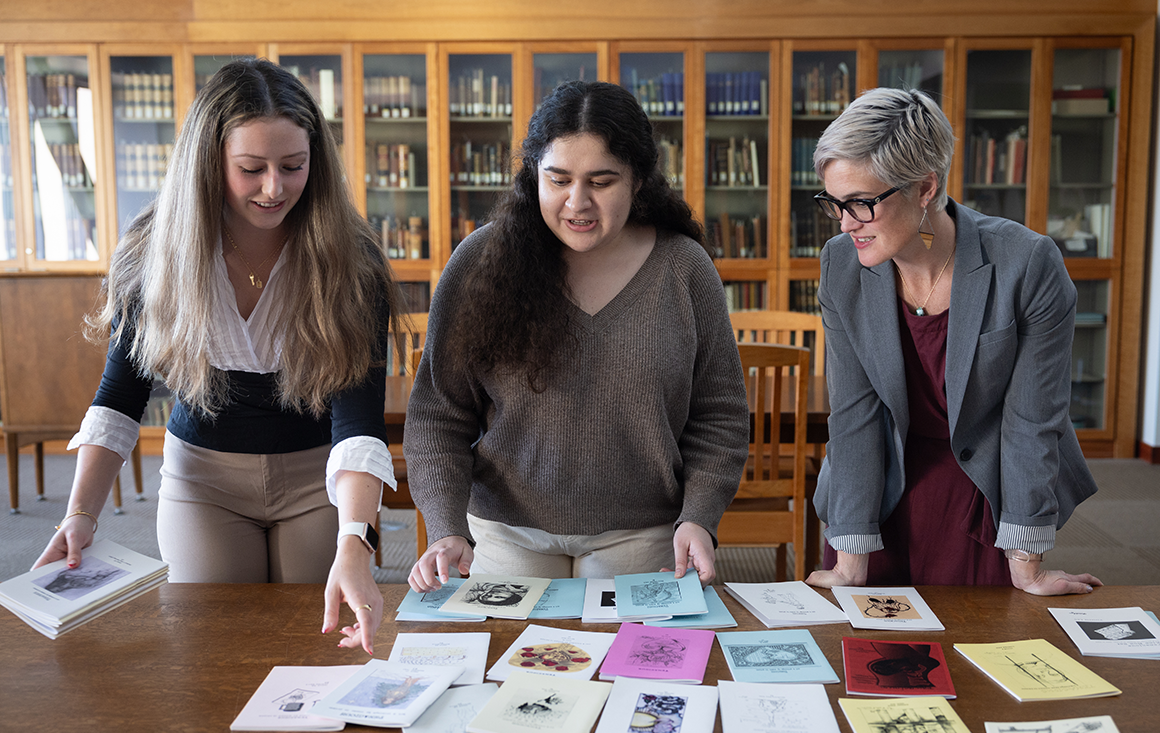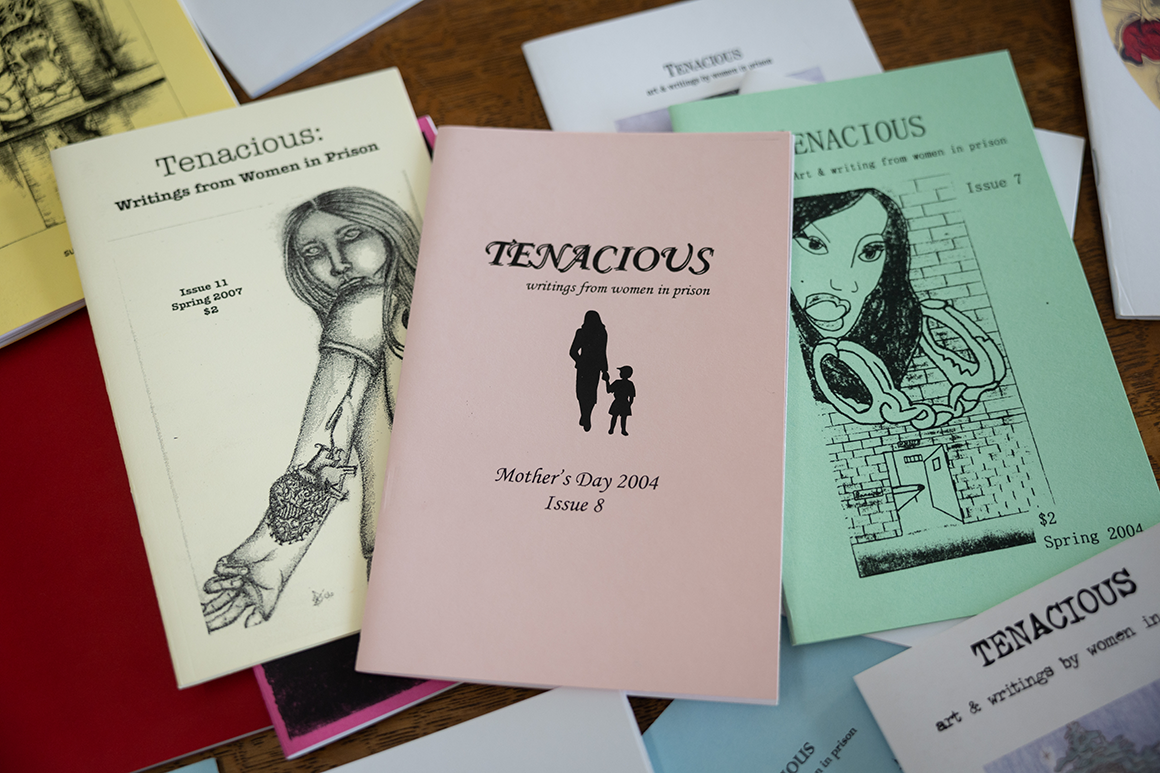Cataloging a New Canon

If you ask associate English professor Kirstyn Leuner what separates Barrilee Bannister and Yraida Guanipa from the likes of Emily Dickinson and Toni Morrison, she would likely point to the biggest thing standing between these talented writers and the rest of the world: the prison walls they write behind.
As a scholar of 18th-century women’s literature, Leuner has always looked to uncover lesser-known or lesser-appreciated literature from marginalized voices, a passion, which eventually led her to the stories of those experiencing mass incarceration.
“While I was a postdoctoral fellow, my advisor invited me to a theater performance by Dartmouth students and women in correctional facility, and that performance changed my life,” she recalls. “I had never been in a facility like that before, and I became so aware that the system is built to keep people with privilege from knowing anything that’s going on inside them, including the beautiful art being created there.”
Challenging these physical barriers and the rigid notion of what can be considered “literature,” Leuner has joined a growing number of Santa Clara University scholars focusing on the intersection of humanities and mass incarceration by bringing art created behind bars into her syllabus.

Natalia Cantu ’24 and Maddie Moran ’24
Holding humanity in one’s hand
Maddie Moran ’24 and Natalia Cantu ’24 were in their sophomore year when they first visited the Archives & Special Collections section of Santa Clara’s library—a trip organized for Professor Leuner’s ENG 68 class, “Women’s Prison Writing.”
There, in the archives, a box was opened, revealing the Tenacious Zines Box Set—a collection of 44 zine issues published by prison abolitionist Victoria Law across two decades featuring art, poetry, essays, political statements, crossword puzzles, and more created by hundreds of incarcerated women across the United States. Zines, which emerged as early as the 1930s, are small, self-published pieces usually made using a photocopier and for a niche audience.
Leuner had centered the course around this zine collection, believing her students would feel a more immediate and prescient connection to these homemade zines than reading an overly academic “prison canon.” In many critical anthologies, Leuner explains, the subjects’ lived experiences can feel depersonalized or glossed over in favor of more theoretical or privileged texts that dominate what defines a “canon.”
“Women are some of the fastest growing populations of incarcerated people, but they often don’t have the same resources that men’s facilities do. As a result, their needs, experiences, and voices are different than incarcerated men, who are overrepresented in existing prison writing archives,” Leuner adds.
For many students, their only exposure to women in prison was from fictionalized shows like “Orange is the New Black,” so the myriad of deeply personal issues featured in these zines—from motherhood to addiction, sexual harassment to prison healthcare—were particularly eye-opening for students.
“Reading the Mother’s Day-themed issues always tugs on my heart,” recalls Cantu. “A lot of the women struggle being separated from their young children, and having to hear about their children through letters, or not being able to have visits because of court orders.”
“A lot of times when we read someone’s story that’s very different from our own, it can be really hard to relate,” Moran adds. “Like, I’m not a parent, I’ve never been incarcerated, and I’ve lived a very privileged life, so I thought there would be a disconnect when reading these stories, but instead I found this layer of emotion and humanity that allowed us to connect with these women.”
Cantu agrees, noting that physically holding someone’s story in her hands emphasized the connection between reader and writer—a rarer experience in today’s digital world.
“I realized how helpful it was to go to places like the library and actually check out things and see these zines in person,” she says. “I think if I had only seen them online, I wouldn’t have been able to see the different textures of the paper, the size of the drawings, the Xerox imperfections.”

The new frontier of digital humanities
But for all the charm that holding a self-published zine can have, digital tools have an important role to play in the academic study of these women’s stories, says Leuner. The emerging field of digital humanities is all about transforming the written word into more accessible and dynamic formats for a wider audience—this might involve digitization, interactive websites, mapping tools, or developing research catalogs.
“The beauty of digital humanities is that it makes knowledge accessible for the public to both learn from and contribute to,” Leuner says, “and it comes with a lot of responsibility.”
As it stands, SCU owns one of the only complete collections of the Tenacious Zines in the world. On top of their rarity, the zines themselves can be quite difficult for researchers to navigate. Some zines have page numbers, others don’t. Some have tables of contents, others don’t. Content types vary widely from issue to issue, with genres easily blending and overlapping. So, while the zines can’t be scanned and digitized because of privacy concerns, Leuner believed there were still ways to improve digital access to this collection by making the contents easier to sift through.
She connected with Moran and Cantu about creating a digital humanities project around this challenge, and the two were awarded student fellowships with SCU’s Center for the Arts and Humanities to pursue their work.
“I think something really cool about digital humanities is that because it’s a growing and evolving field, you can be super creative because there’s no one way to go about it,” says Moran. “For the Tenacious Zines project, I’m not super technologically savvy, but I wanted people like me people who are interested, even on just a surface level, to be able to access these stories in a way that was hassle-free.”
This process of cataloging the hundreds of writings and art within the zines was an ongoing and collaborative challenge for Moran and Cantu. Starting with one of the most accessible organization tools, Google Sheets, the catalog and library guide Moran and Cantu created categorized zine pieces by broad themes and genres, logged author names and publication year, and highlighted other important details, like accompanying illustrations. If a researcher could determine what issues they needed to access, they would be able to visit the SCU library and quickly find what they were looking for.
Beyond making this rare collection more accessible to both academics and the public, Leuner notes the tangible impact the project had on her students’ skills as scholars, deepening their critical thinking and interpretative skills, skills which have real impacts on how the source material is perceived by researchers.
Additionally, working so closely with these texts has influenced Cantu and Moran’s post-grad careers in different ways.
Drawn in by each zine’s visual language of pictures, colors, and formatting, Cantu combined her love of English and biology to become a stronger science communicator and is now a graduate researcher at Stanford University. Meanwhile, inspired by issues of race, language, and immigration within works by Yraida Guanipa, Moran is now pursuing a law degree at Syracuse University.
“Reading these zines really demonstrated that justice is not a binary concept. It’s multi-faceted and, currently, disproportionate at best,” says Moran. “It’s important that we look at justice inside the prison system as well.”
It’s that connection between literature and action that makes this work, particularly within a Jesuit university, so powerful, says Leuner.
“Being exposed to the real stories of real people, and being the conduit through which these stories can be heard imbues a real responsibility to learn more and continue to turn towards these marginalized voices, not away.”
Santa Clara's Center for the Arts and Humanities (CAH) regularly partners with on- and off-campus groups, organizations, and communities to build capacity, locate new resources, serve the community, and advocate for the arts and humanities.


